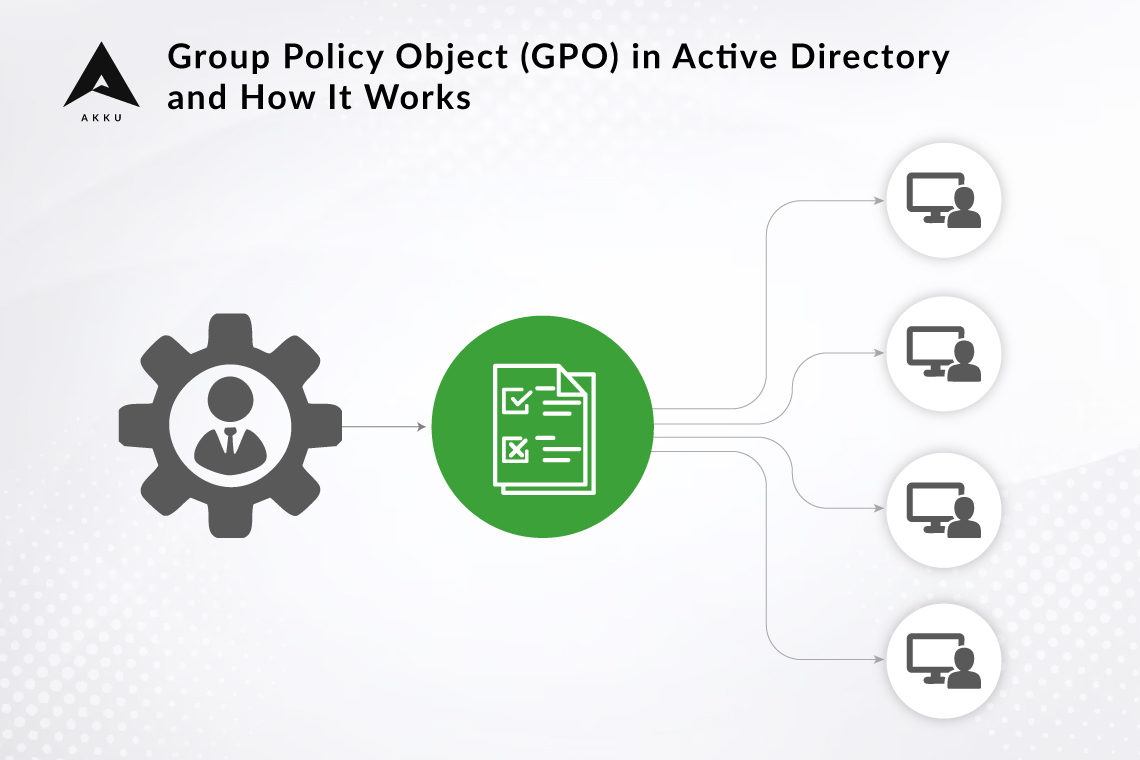Imagine walking into a company where every desktop looks different, passwords are handwritten on sticky notes, and users are free to install whatever software they fancy. It might sound chaotic, but that’s exactly what happens when there’s no policy control in place.
For decades, Group Policy Objects (GPOs) have been the backbone of IT governance in Windows environments, enabling administrators to enforce consistency, security, and compliance across their networks. But as businesses move to hybrid and cloud-first models, it’s time to revisit the basic question: What is GPO in Active Directory, and is it still enough?
This blog takes you through the core mechanism of Group Policy Objects, how they work, their real-world applications, and why IT teams are increasingly adopting modern alternatives like Akku for centralized access control.
What is a Group Policy Object (GPO) in Active Directory?
Definition and Purpose of GPO
Let’s start with the basics – what is a GPO?
A Group Policy Object (GPO) is a set of rules that administrators apply to user and computer accounts in an Active Directory environment. These rules control system behavior, security settings, and user experience, ensuring consistency across all devices.
In other words, the GPO prevents users from going rogue, delivering centralized governance across devices and users at scale.
Local Group Policy vs. Domain-Based GPO
There are two primary Group Policy Object types:
- Local Group Policy applies only to a single machine and is managed independently.
- Domain-Based GPO is managed through Active Directory and applies settings to groups of users or devices across the network.
In most enterprise environments, domain-based GPOs are essential for efficient administration and scalable control.
GPO Scope: User and Computer Configuration
GPOs are structured into two scopes:
- User Configuration: Controls the user environment – desktop settings, application access, folder redirection, and more.
- Computer Configuration: Applies system-wide settings like firewall rules, password policies, and software controls.
This dual structure makes GPOs highly flexible and powerful.
Inside the Architecture – Components and Storage of GPO in Active Directory
Every Group Policy Object is made up of:
- Group Policy Template (GPT): Stored in the SYSVOL folder of domain controllers; contains policy files, scripts, and templates.
- Group Policy Container (GPC): Stored in Active Directory; holds metadata such as version, status, and permissions.
Together, these define the structure and logic of each GPO. This architecture allows for replication, tracking, and fine-grained control across a network.
Deployment Mechanics – How Are Group Policy Objects Applied Across the Network?
GPOs follow a specific order when applied, known as LSDOU:
- Local
- Site
- Domain
- Organisational Unit (OU)
The closer a GPO is to the object (like a user or computer), the higher its priority, unless overridden. Policies refresh every 90 minutes by default, but can be manually updated using gpupdate /force.
Understanding this sequence helps in avoiding conflicts and ensures the intended policies take effect.
Strategic Use Cases – Real-World Applications and Advanced GPO Scenarios
GPOs are not just technical tools – they’re strategic enablers. Here’s how they shine in real-world scenarios:
- Strengthening Security: Enforce strong password rules, disable USB ports, or restrict local admin rights.
- Enhancing User Experience: Standardize desktops, configure printers, and control access to features like Task Manager or Control Panel.
- Application Management: Block unauthorized software or automate installations organization-wide.
- Network Access Control: Manage proxy settings, disable public Wi-Fi connections, and enforce VPN usage.
Each of these examples shows how a Group Policy Object improves security and productivity while reducing manual overhead.
Optimizing Control – Best Practices for GPO Configuration, Security, and Troubleshooting
Getting the most out of GPOs requires a disciplined approach. Here are a few best practices:
- Don’t overcomplicate: Consolidate GPOs where possible to reduce processing time.
- Use clear naming conventions: Make it easier for teams to manage and troubleshoot.
- Test before deploying: Use test OUs to validate policy behavior.
- Audit and monitor: Regularly check gpresult and event logs for compliance and anomalies.
- Document everything: Especially helpful when multiple admins are involved.
These steps ensure your GPO setup remains efficient, secure, and easy to maintain.
Why Are Forward-Thinking IT Teams Shifting to Centralized Access Solutions?
Limitations of Traditional GPOs in Hybrid and Cloud Environments
As workforces become more remote and cloud-centric, traditional GPOs face several limitations:
- Inability to manage non-domain devices
- Lack of visibility into real-time policy enforcement
- Dependency on on-prem infrastructure
- Complex setup and maintenance
In short, traditional Group Policy Object models weren’t designed for today’s mobile, distributed environments.
The Shift to Zero Trust and Centralized Access Control
Modern IT security follows a Zero Trust model – don’t trust, always verify. This requires:
- Device-aware policy enforcement
- Identity-based access control
- Real-time monitoring and compliance
GPOs are static and domain-bound, making them ill-suited for this dynamic, cloud-driven world.
Increased Demand for Security and Compliance
Regulations like GDPR, HIPAA, and ISO 27001 demand continuous visibility and control over user and device activity. Traditional GPOs offer limited support for audit trails and flexible compliance reporting.
That’s why many IT leaders are moving towards solutions that are built for the future.
AKKU – Empowering Enterprises with Modern Access Control Beyond Traditional GPOs
Enter Akku GPO Manager – a cloud-based, platform-agnostic alternative that provides all the benefits of GPO, and more.
With Akku, IT teams can:
- Centrally enforce security policies across Windows, macOS, and Linux
- Configure firewall, MFA, and password rules without relying on Microsoft infrastructure
- Apply data privacy controls, such as disabling screen capture, USB ports, cloud storage, and private browsing
- Monitor compliance through detailed audit logs (USB activity, login/logout, software installs)
- Push policies to specific users, devices, or groups via a single intuitive dashboard
This is a Group Policy Object reimagined for the modern enterprise – flexible, secure, and built for the hybrid workforce.
Looking to modernize your policy control without the complexity of legacy systems? Let’s talk. Akku might be exactly what your IT stack needs.












